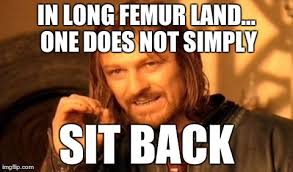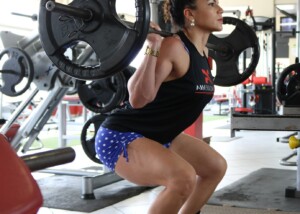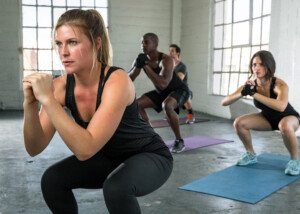There is solid truth to the claim that a bad femur to torso ratio will make back squats very difficult; learn why this is not a lame excuse!
Are you one of those “bro science” guys who slams some dude in a fitness forum because he blames his back squat problems on long femurs and a short torso?
That’s odd, because it’s Physics 101.
It’s also a matter of halfway-decent vision, when you view the two images below.

The one above shows lousy squat proportions;
in the one below are blessed squat proportions.

Do you really think the guy in the first photo shouldn’t have a much harder time with the back squat, with those relatively long femurs having to go through a greater arc of motion — relative to the shins — to get parallel to the floor?
Imagine him squatting. Then imagine his better-proportioned twin doing the same. Come on now, who’s going to have a real bear of a time here?
And no, the difference isn’t a bigger pair of pants. Look again at the torsos, then the femurs, then the shins.
Short femur athletes know only one thing: What the back squat feels like with short femurs and a long torso (or at least, a torso that’s not shorter than his femurs).
Likewise, the person with the “biomechanical disadvantage” knows only one thing:
That he will fall backwards as he lowers into a half squat, unless he pitches his torso WAY forward — maybe even turning his squat into a good morning.
Though there are those with long femurs and a short torso who actually perform the back squat, you should realize that piling on heavy weights is not a smart idea because their lower back is forced to absorb a lot of tension.

Marvel of nature: Long femurs, short torso, very heavy weight load.
The long femur short torso person who accomplishes a squat does so at a few costs:
1) The lower back is forced to absorb tension that is supposed to be taken up by the glutes and legs, and 2) This type of body may learn to over-dorsiflex the ankles, putting undue stress on the knees.
So even though they can boast, “I have long femurs and a short torso but I can deep squat without rounding my back,” remember those two cost elements.
The lower back muscles (which stabilize the spine) are not designed for force production; the glutes, quads and hams are.
When forces are imposed on them that they are not designed to handle, the risk of a ruptured disk becomes higher, and what becomes even greater is a soft-tissue injury.
A person with short femurs and a long torso is capable of bad form in the squat, but this bad form can be corrected with a little practice.
For those with long femurs and short torso, they do not have the same choices.
Their long femurs throw their hips out so far as they lower into a squat, that to counterbalance this, they must lean their torso way forward.
Try this Experiment
Sit in chair that makes your thighs parallel. How far must you lean forward to get your shoulders over your ankles — while keeping a lower arch in your back? For many of you, it won’t be far; you may be virtually upright yet.
Now, imagine that several inches have been slashed from your torso. This displaces your shoulders back by several inches.
This forces you to lean forward MORE to get your shoulders above the ankles! The shorter your torso, the more you have to lean forward.
Or, the longer your femurs (which make the feet further from your center of gravity), the more you must lean the torso forward!
This situation is more prevalent in women. Look at a photo of a woman and man of equal height standing side by side.
Usually the woman’s waist is higher and her legs are longer. Though she may not have long femurs relative to her overall leg length, her femurs may still be longer than her short torso!
This puts her at a biomechanical disadvantage in the squat.
Though some women have visibly long torsos and stubby femurs, this is not the typical build of a woman.
View this video (hopefully it’s still up) of a man with long femurs and a short torso performing a back squat, and if you’re still a critic of this “excuse,” tell me how this man can get his back even a little more upright without falling backwards.
He’s already quite bent over early on in the squat, just to keep from falling backwards.
To the untrained eye, it appears that his form is poor, and I’ll admit, it can be improved despite his “levers.”
But look what he must do to get his shoulders over his feet.
Pause the video right when he gets into the deepest point of the squat.
Imagine him getting his back more upright. Note what would happen to the alignment of his shoulder over his feet; the imaginary vertical line between the two points would be shifted towards behind him at the top — which would send him pitching backwards to the floor!
He has no choice but to fold up to offset the distance his hips are from his knees as he squats.
A longer torso (or shorter femurs) would enable a more upright back, and hence a strong lower back arch.
I’m sure that the forum posters who criticize the long femur to short torso defense would never criticize the guy with the T-rex arms who says his deadlift bombs because of his short arms. Let’s face it: Anthropometrics can’t be ignored.










































